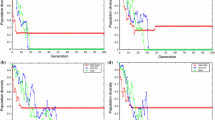Abstract
The rate of mutation has deep effects on the performance of genetic algorithm (GA). Current mechanisms to control mutation rate (MR) utilize the mathematical functions which usually are monotonic. These mechanisms are too rigid and inflexible. These methods change the MR without enough attending the position of GA. For instance these methods don’t attend whether GA is in trap or not. This research proposes a novel mechanism which controls MR by an algorithm which uses a concept of defined local trap. This algorithm probes whether GA is in the local trap or is not. In case of local trap, it changes the MR. This methodology is named MRCA (Mutation Rate Control Algorithm). To evaluate performance of MRCA, it is applied to multimodal continuous optimization functions and also a type of combinatorial optimization problem. The results show that MRCA outperforms other state-of-the-art strategy in term of accuracy and speed.
Similar content being viewed by others
References
Zhang J., Zhuang J., Du H., Wang S.: “Self-organizing Genetic Algorithm Based Tuning of PID Controllers,”. Information Sciences 179(7), 1007–1018 (2009)
Park T., Ryu K. R.: “A dual-population genetic algorithm for adaptive diversity control,”. IEEE Transactions on Evolutionary Computation 14(6), 865–884 (2010)
Lim T. Y.: “Structured population genetic algorithms: a literature survey,”. Artificial Intelligence Review 41(3), 385–399 (2014)
Dick, G., “The spatially-dispersed genetic algorithm,” in Proc. of the 2003 international conference on Genetic and evolutionary computation: PartII, 2003.
Lozano M., Herrera F., Cano J. R.: “Replacement strategies to preserve useful diversity in steady-state genetic algorithms,”. Information Sciences 178(23), 4421–4433 (2008)
Oliver K.: “Evolutionary self-adaptation: a survey of operators and strategy parameters,”. Evolutionary intelligence 3(2), 51–65 (2010)
Thierens, D., “Adaptive mutation rate control schemes in genetic algorithms,” in Congress on Evolutionary Computation, 2002.
Zhang J., Chung H. S.-H., Lo W.-L.: “Clustering-Based Adaptive Crossover and Mutation Probabilities for Genetic Algorithms,”. IEEE Transactions on Evolutionary Computation 11(3), 326–335 (2007)
Lin L., Gen M.: “Auto-tuning strategy for evolutionary algorithms: balancing between exploration and exploitation,”. Soft Computing 13(2), 157–168 (2009)
Pereira, A. G. C., Roveda, J. A. F. and Carlos, L. A., “Convergence analysis of an elitist non-homogeneous genetic algorithm with mutation probability adjusted by a fuzzy controller,” in IFSA World Congress and NAFIPS Annual Meeting, 2013.
Wang L., Tang D.-B.: “An improved adaptive genetic algorithm based on hormone modulation mechanism for job-shop scheduling problem,”. Expert Systems with Applications 38(6), 7243–7250 (2011)
Jungsup S., Dong H. K.: “Subcarrier and bit allocation scheme for the ma problem based on the ant colony optimization to minimize power consumption in of dma systems,”. International journal of innovative computing, information and control 7(8), 4755–4764 (2011)
Tang P.-H., Tseng M.-H.: “Adaptive directed mutation for real-coded genetic algorithms,”. Applied Soft Computing 13(1), 600–614 (2013)
Srinivas M., Patnaik L. M.: “Adaptive probabilities of crossover and mutation in genetic algorithms,”. IEEE Transactions on Systems, Man and Cybernetics 24(4), 656–667 (2002)
Hwang S.-F., He R.-S.: “A hybrid real-parameter genetic algorithm for function optimization,”. Advanced Engineering Informatics 20(1), 7–21 (2006)
Gong D., Guo G., Lu L., Ma H.: “Adaptive interactive genetic algorithms with individual interval fitness,”. Progress in Natural Science 18(3), 359–365 (2008)
Eshelman, L. J. and Schaffer, J. D., “Real-Coded Genetic Algorithms and Interval-Schemata,” in Fundations of Genetic Algorithms 2, 1993.
Mühlenbein H., Schlierkamp-Voosen D.: “Predictive models for the breeder genetic algorithm i. continuous parameter optimization,”. Evolutionary Computation 1(1), 25–49 (1993)
Wang H., Wu Z., Rahnamayan S.: “Enhanced opposition-based differential evolution for solving high-dimensional continuous optimization problems,”. Soft Computing 15(11), 2127–2140 (2011)
Ismkha, H. and Zamanifar, K., “Developing Improved Greedy Crossover to Solve Symmetric Traveling Salesman Problem,” 2012. arXiv:1209.5339.
Ismkhan, H. and Zamanifar, K., “Developing Programming Tools to Handle Traveling Salesman Problem by Three Object Oriented Languages,” Applied Computational Intelligence and Soft Computing, 2014.
Author information
Authors and Affiliations
Corresponding author
About this article
Cite this article
Ismkhan, H. A Novel Intelligent Algorithm to Control Mutation Rate Using the Concept of Local Trap. New Gener. Comput. 34, 177–192 (2016). https://doi.org/10.1007/s00354-016-0207-0
Published:
Issue Date:
DOI: https://doi.org/10.1007/s00354-016-0207-0




